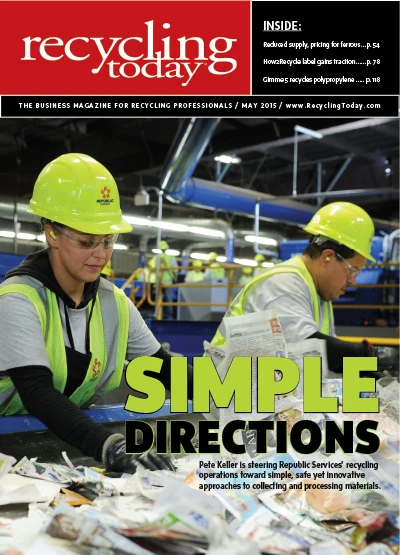Any expectation that nonferrous markets would bounce back after China’s Lunar New Year in February have been dashed. As of mid-April, the tone of the nonferrous market is almost universally bearish.
Almost to a one, scrap metal recyclers are expressing concern that the extended market downturn has left them in critical condition.
The lack of generation remains a foremost concern. Despite the relative strength of the U.S. economy, sources say they are having a tough time getting sufficient supply across their scales. Margins also remain exceptionally narrow, they say, making profits difficult to come by.
The strong U.S. dollar is working to price loads of nonferrous scrap outside of the reach of many offshore markets. Not only has the strong dollar made it more expensive to ship offshore, but several dealers say they also are seeing an uptick in the import of nonferrous metals from Europe.
Looking to the future, many scrap dealers say few signs signaling a turnaround are visible, and they are writing off most of this year as a continuation of soft markets.
Copper, aluminum and nickel are in difficult positions at present, with muted global demand putting downward pressure on prices. One copper scrap dealer says that while some of his colleagues feel a fairly recent uptick in copper scrap prices could continue, a more pervasive sentiment is that after a short rally, prices could drop to the $2-per-pound range in the near future.
“There is extreme talk about markets on both sides,” he notes.
While he terms the copper scrap market “reasonable” currently and in balance, he says that supply “is not that high.” He adds, “Copper markets are fickle right now.”
While copper markets rallied quite a bit in early April, with prices topping some short-term highs, there doesn’t appear to be much confidence that the higher prices will hold, he says.
A large aluminum scrap dealer says the strong U.S. dollar has him feeling bearish about the outlook for this metal. “Right now the problems are that demand is spotty. Secondaries have been flooded with [scrap] supply. While demand [for their products] is strong in some areas, the automotive market is getting flooded [with finished aluminum],” he adds.
Several other sources in the Midwest are expressing similar sentiments.

“Tough times,” one larger scrap processor says of nonferrous scrap markets presently. “There is just less volume out there.”
Encapsulating the current environment, another scrap metal dealer says, “Three to four years ago, I was getting 20 calls a month. Now, I am getting three calls a month.”
Perhaps eventually helping to ease finished aluminum oversupply, South American primary capacity is being reduced sharply. According to John Mothersole, director of research, pricing and purchasing services for the consulting firm IHS, headquartered in Englewood, Colorado, in commentary provided to the Aluminum Association, Arlington, Virginia, says Brazilian primary production has fallen to less than 900,000 metric tons, a sharp difference from the 1.66 million tons of production in the country in 2008.
Mothersole says traditionally South American aluminum exports have helped to cover North American deficits.
On a more positive note, the Aluminum Association reports that the U.S. aluminum sector purchased an estimated 785 million pounds of aluminum scrap during January 2015, a 6.1 percent increase from the same time last year.
Further, the U.S. Geological Survey (USGS), which tracks aluminum scrap figures, estimates that the January domestic recovery of aluminum and aluminum alloys totaled 671 million pounds, 6.6 percent above January’s 2014 total of 629 million pounds. However, reflecting the difficult environment for exporters, the USGS reports that the exports of scrap, not included in the government’s consumption statistics, totaled 225 million pounds, a 23.7 percent decrease from the same time last year.
“People involved in the trenches are not sure what to make of the market,” a second Midwestern scrap dealer says.
The tough supply situation is not limited to aluminum. Another source says that even though China has been fairly quiet, insulated wire “is still tough to get.” The grade had been a favorite of Chinese buyers, and there is still some buying, though not at the levels seen several years ago.
Reflecting the continued problems with China, the recent Purchasing Managers Index for China’s manufacturing sector, as reported by the Chilean Copper Commission, hit an 11-month low in March, falling to 49.2, indicating a contraction in economic growth. The market projected a figure of 50.6. These weak figures could motivate the government to develop a more expansionary policy to stimulate the economy.
In response, Chile, which produces one-third of the world’s copper, is expected to export slightly less copper than it originally forecast.
Nickel and stainless scrap may soon see a healthy bounce. Indonesia’s ban on the export of ores forced China to build up its stocks on hand. With Indonesia’s export ban still in place, several sources say they expect to see China aggressively returning to the market to build up inventory.

Explore the May 2015 Issue
Check out more from this issue and find your next story to read.
Latest from Recycling Today
- Aqua Metals secures $1.5M loan, reports operational strides
- AF&PA urges veto of NY bill
- Aluminum Association includes recycling among 2025 policy priorities
- AISI applauds waterways spending bill
- Lux Research questions hydrogen’s transportation role
- Sonoco selling thermoformed, flexible packaging business to Toppan for $1.8B
- ReMA offers Superfund informational reports
- Hyster-Yale commits to US production





